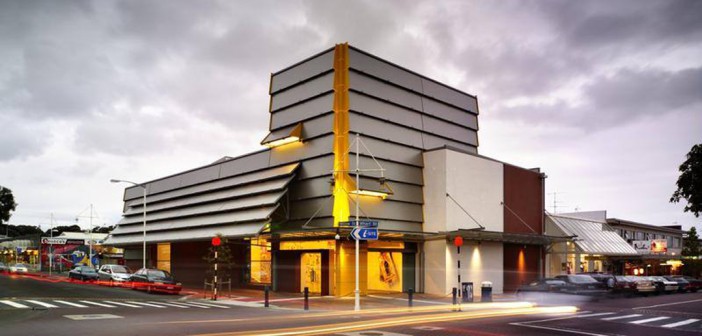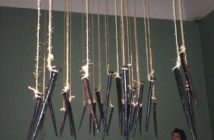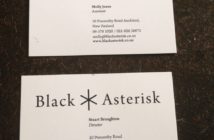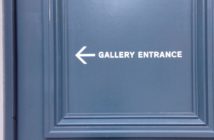Tauranga Art Gallery’s current set of exhibitions is like a carefully selected dinner. They are a varied plate of beautiful items each totally delightful on their own but combined making a visual feast (with apologies to Lyn of Tawa).
The Tauranga Art Gallery resides in a former bank building – tall, solid and seemingly strong in the heart of old downtown Tauranga and a spit from its reclaimed waterfront. Standing opposite the principal Tauranga City Council building the gallery’s large windows front Willow Street and the major bus hub for the locale. I’m always saddened by the waiting rows of passengers with their backs firmly placed away the freely accessible interior of the gallery. A lost captive audience?
The Tauranga Art Gallery has an immediate wonderful feeling of space. From the road you go through two sets of glass doors into The Atrium Gallery. No it’s not the breathtaking openness of the Queensland State Gallery in Brisbane but for the size and cost of the gallery you are immediately in a floor to ceiling exhibition space. Gallery exhibitions have made outstanding use of the height and visual impact of The Atrium Gallery with often hit you in the eye larger work showings that would be squashed in other of the gallery spaces. This time it’s the work of Ewan McDougall. McDougall’s large colourful works definitely hit you in the eye and beat you about the visual head the minute you step inside.
All of the works are titled; “…the last stroke is always the title…” says McDougall’s artist’s statement. There is something cartoonish, childish, weird, scrawled about these Aboriginal and African referenced art works. My eyes see frenetic clumps of multi-coloured people crammed in spaces. One looks like a fireworks display; I see it’s titled “Blast Off” Most of works look as though McDougall was having a great deal of fun painting and creating and the multi-coloured frenetically energetic images provide the desired foil to the Aberhart exhibition in the adjacent gallery.
To describe Laurence Aberhart’s as black and white photographs doesn’t describe their multi-toned records of public memory. ANZACS is an outstandingly beautiful collection of photographic compositions themed around the ubiquitous and repetitive war memorials dotting Australia and New Zealand. It’s an exhibition of many images and fills the large downstairs Gallery and the Vault Gallery. I take the time to read the introductory statement. There are other visitors in the Gallery, not many bother to read it and most walk around the exhibition with the speed of a pre-Christmas window shopper.
I’ve looked at the photographs three times now. Twice the first time I went and a third time as merely a once-over lightly. The photographs don’t engage me emotionally as a remembrance of historic human sacrifice or make me think about the validity or futility of war. They are distant and removed and eerily silent and although I marvel at them as photographic compositions they leave me cold. I’m more emotionally moved by those tragic little white crosses grieving families plant on roadsides and those back window memorials on lowered Subaru station wagons. I tell Teurin the Gallery staffer how I feel ; she explains to me the ethos behind the exhibition and with me it’s succeeded.
Later I wonder if the photographs may be misleading as to the on-going value and significance of these conventional memorials in regional New Zealand. The photographs suggest isolation and discontinued social relevance. One urban example is juxtaposed against its international fast food chain neighbour. In one or two instances long grass and rundown surrounds indicate ongoing community neglect.
But the majority of the memorials are well-cared for. One of the images is of the little town nearby the rural area I lived in. The conventional plinth memorial stood by what, before the development of the southern car-park, had been the main road south. I drove past that memorial several times a week. I remember stopping, no not often and not for ANZAC services, and reading the names on the side. They were names I recognised as those families still lived in general area. On ANZAC day after the dawn service it was appropriately littered with rapidly fading flowers and wreaths.
The memorial in the rural area was a “war memorial hall”. It was the centre of on-going life and activity. Before the playcentre was built it was the playcentre. It was the school hall. It was the meeting venue for the Country Women’s Institute, the Fedi Farmers, contentious public meetings, 21sts, dances, country markets and funerals. It was an ongoing living part of a thriving community. I wonder if the overgrown images are more a testament to regional downturn and neglect generally?
Lest we forget. Well we do. Ask any twenty something. Perhaps that’s why the Holocaust Museum and Selma are so important.
The World Wildlife Exhibition is on the upper gallery level. There are lots of people in here on the occasions I go to look at these amazing photographs of the natural world. The exhibition is a display of the images of category finalists. They are displayed in the contest categories.
A gallery staffer tells me for many it’s the first time they’ve been in the Tauranga Art Gallery. Progress round this exhibition is demonstrably slow. Most of the viewers are reading the explanatory statements accompanying each photograph. I stand and listen. Pairs of viewers talk with each other about the images and the statements.
And there are all sorts of adults and children. A mother crouches with her very young son explaining the photo-journalism collage of a lion attack. Three brightly clad mature women create their own photoworthy image as they intently view the Mammals photographs. Two Cargo shorted and croc wearing men form their own composition as they lean into the display and talk and explain. Perhaps the talk is of places they have come from?
On my third visit to this exhibition I sit and watch the three time-lapsed sequences. The wildebeest stream across the landscape of the Serengeti and the Masai Mara like ants looking for candyfloss. Childlike I watch this repeatedly so I can see the three hippos appear and disappear in the river and make out the one or two white ibis on the bank. I’m left with an overwhelming desire to talk to the first wildebeest – why did they do it? The regenerative process of a controlled grassburn and the freezing and unfreezing effects of northern winter are also watched repeatedly.
I peer back into this section of the exhibition before I leave and there is a young father with two very little boys sitting watching the time-lapse sequences. One of the little boys is on his father’s knee, leaning against him, small head tucked up against his father’s chest and under his chin. The other boy is leaning comfortably against his Dad chirping questions. The people who worked so hard to create the Tauranga Art Gallery for us would be smiling now.
This is an exhibition of images everyone can immediately relate to and understand. It’s an enjoyable exhibition and like a supermarket loss leader it’s a viewer magnet. I assume that this exhibition and the accompanying exhibitions must have been organised under the watch of recently retired Gallery Director Penelope Jackson. What a great memorial for her contribution to the development of the Tauranga Art Gallery.
What did I like looking at best of all? The tiny exhibition Gifted 3 – it’s a selection of work from the gallery’s own collection. It’s not a big display but it’s varied and interesting. It’s also very cleverly placed to catch viewers leaving the World Wildlife exhibition. As I’m walking down the stairs I take yet another look at the wonderful images to support the existence of whales. These images have been here for a while and I hope they remain a lot longer not just because of their subject matter but because of their diverse styles.
There is no charge to enter the Tauranga Art Gallery although donations are gratefully accepted. The Tauranga Art Gallery is owned and run by a charitable trust with significant financial support from the Tauranga City Council, local business and individuals both past and present. Opposite the local iSite the Gallery is located within very easy walking distance of the Tauranga waterfront with its cafes, restaurants and bars. There is roadside pay for parking in and around the area. The Gallery is also an easy walk from parking buildings. It’s open nearly everyday of the year (excepting Christmas Day and Good Friday) from 10am to 4pm. It has regularly changing exhibitions and is worthy of regular and repeated visits.
Tauranga Art Gallery, 108 Willow Street, Tauranga Admission is free but donations are greatly appreciated www.artgallery.org.nz Phone 07 578 7933
Rosemary Balu
Rosemary is a regular contributor to ARTbop and is the founding and current Editor of ARTbop.





